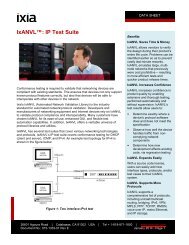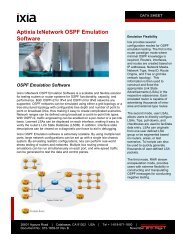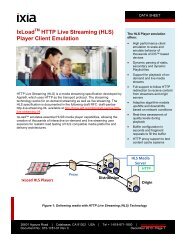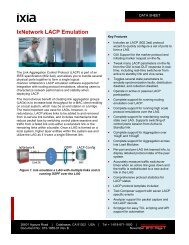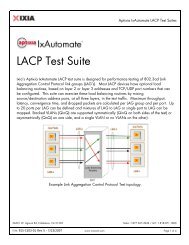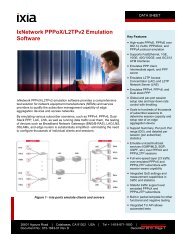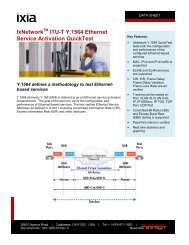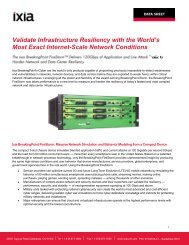10-Gigabit Ethernet Switch Performance Testing - Ixia
10-Gigabit Ethernet Switch Performance Testing - Ixia
10-Gigabit Ethernet Switch Performance Testing - Ixia
Create successful ePaper yourself
Turn your PDF publications into a flip-book with our unique Google optimized e-Paper software.
Developing the<br />
Right Test<br />
Methodology<br />
Understanding the stress points in a<br />
switch allows the development of a test<br />
methodology that can focus on testing<br />
these areas. The test methodology should<br />
address multiple layers, and could include<br />
measuring for:<br />
• Wire speed unicast data throughput<br />
and latency for Layer 2/3 traffic.<br />
• The ability to filter packets at wirespeed<br />
based on MAC addresses, IP<br />
addresses, TCP or UDP ports, or a<br />
combination of these (N-tuple).<br />
• The ability to perform prioritization<br />
based on QoS marking.<br />
• The ability to police traffic based on<br />
user-defined rate limits.<br />
• The ability to handle Head-of-Line<br />
blocking (HOL).<br />
• Wire speed multicast performance.<br />
Test methodology example<br />
Following is an example of a test<br />
methodology for a multi-<strong>10</strong>GE port switch<br />
that supports the following features:<br />
1. Wire-rate Layer 2/3 (for IPv4)<br />
switching with a minimum packet<br />
size of 64 bytes.<br />
2. <strong>Switch</strong>ing capacity per slot that<br />
supports total port capacity on line<br />
card.<br />
3. Filtering based on ACLs.<br />
4. QoS handling based on 802.1p or IP<br />
Type of Service (TOS) bits.<br />
5. Priority scheduling based on<br />
weighted round robin (WRR).<br />
6. Traffic shaping.<br />
7. Routing protocols, including<br />
multicast.<br />
The test methodology is broken out into<br />
module- and system-level testing. In the<br />
real world, local switching on the module<br />
occurs; this is the best-case scenario for<br />
switch performance, because there is no<br />
contention for the fabric. The worst-case<br />
scenario is when all traffic entering the<br />
switch must traverse the fabric,<br />
contending for backplane capacity and<br />
causing over-subscription.<br />
Module-level testing<br />
In this scenario, traffic will stay local to the<br />
line card. This means that switching will<br />
occur locally between ports on the same<br />
line card, and minimal traffic will traverse<br />
the backplane.<br />
System-level testing<br />
In this scenario, all of the ingress traffic is<br />
switched to ports on different line cards.<br />
This means that traffic will be contending<br />
for backplane capacity and will determine<br />
how the system handles oversubscription.<br />
It will be set up with partially meshed<br />
traffic patterns, with unique ingress ports<br />
mapped to unique egress ports, and<br />
multiple ingress ports mapped to a single<br />
egress port.<br />
Test methodologies<br />
1. Layer 2 bidirectional throughput and latency<br />
test. This test determines the Device Under<br />
Test’s (DUT’s) maximum Layer 2<br />
forwarding rate without traffic loss as well<br />
as average latency for different packet<br />
sizes. This test is performed full duplex<br />
with traffic transmitting in both directions.<br />
The DUT must perform packet parsing and<br />
Layer 2 address look-ups on the ingress<br />
port and then modify the header before<br />
forwarding the packet on the egress port.<br />
2. Layer 2 throughput, QoS, and latency test.<br />
This test determines the DUT’s maximum<br />
Layer 2 forwarding rate with packet loss<br />
and latency for different packet sizes. The<br />
DUT must perform a Layer 2 address lookup,<br />
check the 802.1p priority bit value on<br />
the ingress port, send it to the designated<br />
queue, and then modify the header before<br />
forwarding the packet on the egress port.<br />
3. Layer 3 (IPv4) performance test with ACL and<br />
latency. This test determines the DUT’s<br />
maximum IPv4 Layer 3 forwarding rate<br />
with packet loss and latency for different<br />
packet sizes. The DUT must perform<br />
16 Copyright © 2004, <strong>Ixia</strong> <strong>10</strong>-<strong>Gigabit</strong> <strong>Ethernet</strong> <strong>Switch</strong> <strong>Performance</strong> <strong>Testing</strong>



